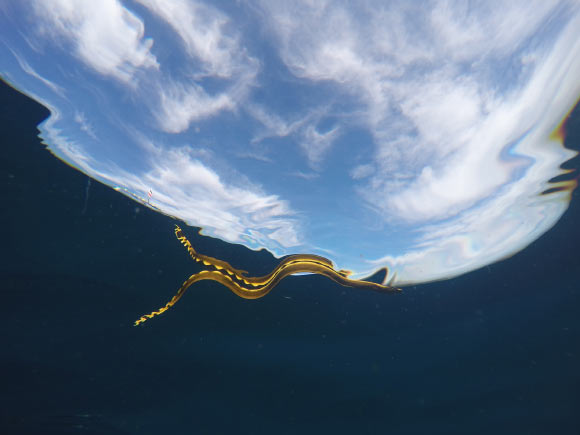Acquisition of freshwater is problematic for sea snakes living in oceanic environments that are distant from sources of freshwater associated with land. These include species living on reefs that are far from land, and especially pelagic snakes in the open ocean. A uniquely interesting species of sea snake is the yellow-bellied sea snake (Hydrophis platurus), which is the only pelagic species of squamate reptile and ranges from southern Africa across the Indo-Pacific to the Pacific coast of Central America. A new study shows that yellow-bellied sea snakes living where there is drought relieve their dehydration as soon as the wet season hits, and do so by obtaining freshwater from ‘lenses’ that form on the surface of the ocean during heavy rain.

The yellow-bellied sea snake (Hydrophis platurus). Image credit: Mark Sandfoss, University of Florida.
The yellow-bellied sea snake is the only reptile in the order Squamata that lives in the open sea.
This species ranges from coastal southeast Africa across the Indo-Pacific to the shores of Central America where the latitudinal distribution includes the Gulf of California to the north and Ecuador to the south.
Given its broad range and seafaring existence, during the dry season it has no access to freshwater.
How yellow-bellied sea snakes survive in regions of drought seems to hinge upon access to freshwater lenses, but little is known about how these marine vertebrates react to or consume rainfall.
“This study contributes to a fuller understanding of how pelagic sea snakes, and possibly other marine animals, avoid desiccation following seasonal drought at sea,” said University of Florida’s Professor Harvey Lillywhite, lead author of the study.
Professor Lillywhite and colleagues captured 99 sea snakes off the coast of Costa Rica (interestingly, the snakes have never been observed in estuaries) and offered them freshwater in a laboratory environment.
The researchers happened to be there just as six months of drought broke and the rainy season began.
They found that only 13% of snakes captured after the rainfall began accepted the offer, compared to 80% of those captured before. The rainfall must have quenched their thirst.
“How these animals locate and harvest precipitation is important in view of the recent declines and extinctions of some species of sea snakes,” Professor Lillywhite said.
“The question remains: How will climate change and its effects on precipitation impact the sea snakes?”
The findings appear online in the journal PLoS ONE.
_____
H.B. Lillywhite et al. 2019. Drinking by sea snakes from oceanic freshwater lenses at first rainfall ending seasonal drought. PLoS ONE 14 (2): e0212099; doi: 10.1371/journal.pone.0212099







